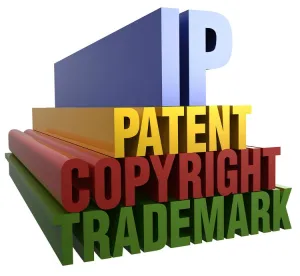Short answer: Yes. As a business owner, you should care about intellectual property because it's one of the most important business assets that you'll ever own.
Intellectual property, often referred to as IP, is a legal term covering various forms of valuable business assets. The three primary areas of IP are trademarks, copyrights and patents.
Many people confuse trademarks, copyrights and patents, frequently referring to copyright when it's really a trademark that they're talking about or calling all IP a patent. Although there are some similarities among these forms of IP, they are very different and serve unique legal and business purposes.
Trademark Overview
A trademark is anything that is used to identify and distinguish the goods or services of one company from those of others. In the business world, a trademark is commonly referred to as a brand name or just a brand. Trademarks (which also covers service marks) include words, names, symbols, logos and taglines/slogans such as “Coca-Cola” and Nike’s famous “swoosh” logo and even the Nike slogan "Do It". Trademarks typically appear on the actual product or its packaging, whereas service marks appear mostly in advertising for the services or on company websites. Trademarks are also essential to the success of franchised businesses such as McDonald's and Subway.
A trademark is one of the most important business assets that a company will ever own because it identifies and distinguishes the company and its products/services in the marketplace from its competitors. Therefore, it is good practice for all business owners to take sufficient action to protect and enforce valuable trademarks.
As a trademark owner, you can stop others, including competitors, from using your trademark or a confusingly similar one. One of several effective ways to protect a trademark is to register it with the state or federal government. (Other blogs and articles by this author have reviewed ways to protect a trademark and the benefits gained by registration and other protection means, as well as the various options to enforce trademark rights and the benefits gained from enforcement.)
Before you and your company adopt and use a new trademark in the marketplace, it is essential that a search is conducted to ensure there is not another trademark already registered or being used in commerce (known as a “common law” trademark) that conflicts with or is confusingly similar to your new trademark; otherwise your use of the trademark can be stopped under the law, costing you valuable time and potentially significant expense.
Copyright Overview
Copyright is a form of protection provided to the creators of “original works of authorship” including literary, dramatic, musical and artistic works. Copyright law generally provides the copyright owner with the exclusive right to use and reproduce the copyrighted work, to prepare derivative works, to distribute copies of the copyrighted work, to perform the copyrighted work publicly, and to display the copyrighted work publicly for a very long time (for example, 95 years after the work is published by your company).
A copyright protects the form of expression (e.g., the writing itself) rather than the subject matter of the writing (such as an invention, which a patent can protect) or the brand name or logo contained in the creative work (which trademark law can protect). Copyrights are registered with the Copyright Office of the Library of Congress (there is not a similar state entity as there is with trademarks).
Copyrights can be used to protect your company’s original creative works – sales brochures, advertising and promotional materials, videos, instruction manuals, photographs and website content – from being used by others without your permission. As a copyright owner, you can control how your work is reproduced, distributed and presented publicly. Importantly, you can stop others (including competitors) from using your copyrighted works or works that are substantially similar to yours.
Registration is not required to own a copyright; simply creating the original work can begin ownership. By registering your work, however, you secure greater, more effective protection.
Patent Overview
While there are three primary types of patents, the two most frequently used are utility patents and design patents.
Utility patents cover the most common types of inventions — those producing a function or result (such as certain machinery and equipment).
Design patents protect purely artistic or ornamental designs for manufactured items that do not affect the function of the manufactured item (such as an ornamental face plate for a watch or unique design feature of an office chair).
A patent is issued by the U.S. Patent and Trademark Office and is effective only within the United States; international patent protection is, however, also available. There is no state patent protection available.
A U.S. patent gives the owner exclusive rights to exclude others from making, using, offering to sell, selling or importing the product into the U.S. for a specific period of time (generally 20 years from the filing date).




 />i
/>i


